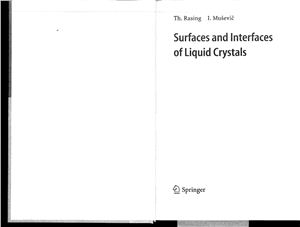Springer, 2004, pages: 296
This book describes the state of the art of our understanding of liquid-crystal interfaces on a molecular level. The interactions of liquid crystal molecules with a surface play an essential role in the operation of liquid crystal displays (LCD's) and other LC devices that are based on the controllable anchoring of LC molecules on polymer coated surfaces.
This book addresses the microscopic interaction between a macromolecule (liquid crystal, polymer) and a wall, using state of the art surface and interface-sensitive experimental techniques, such as Atomic Force Microscopy (AFM), Scanning Tunneling Microscopy (STM), Linear and Nonlinear Optical Microscopy and (Dynamic) Light Scattering (DLS). These experimental techniques were complemented with computer simulations and supra molecular chemistry methods to develop controllable polymeric surfaces.
This book describes the state of the art of our understanding of liquid-crystal interfaces on a molecular level. The interactions of liquid crystal molecules with a surface play an essential role in the operation of liquid crystal displays (LCD's) and other LC devices that are based on the controllable anchoring of LC molecules on polymer coated surfaces.
This book addresses the microscopic interaction between a macromolecule (liquid crystal, polymer) and a wall, using state of the art surface and interface-sensitive experimental techniques, such as Atomic Force Microscopy (AFM), Scanning Tunneling Microscopy (STM), Linear and Nonlinear Optical Microscopy and (Dynamic) Light Scattering (DLS). These experimental techniques were complemented with computer simulations and supra molecular chemistry methods to develop controllable polymeric surfaces.

